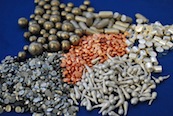Ytterbium Oxide
MATERIAL SAFETY DATA SHEET
I. PRODUCT IDENTIFICATION
Manufacturer/Supplier:
ESPI Metals
1050 Benson Way, Ashland, OR 97520
Toll Free (800) 638-2581 * Fax (541) 488-8313
E-Mail: This email address is being protected from spambots. You need JavaScript enabled to view it.
Product Name: Ytterbium Oxide
Formula: Yb2O3
CAS Number: 1314-37-0
II. HAZARDOUS INGREDIENTS
Hazardous Components: Ytterbium Oxide
Percent (%): 0-100
OSHA/PEL: N/E
ACGIH/TLV: N/E
HMIS Ratings:
Health: 1
Flammability: 0
Reactivity: 0
III. PHYSICAL DATA
Boiling Point: N/A
Melting Point: 2227 oC
Specific Gravity: 9.17 g/cc
Solubility in H2O: Insoluble
Appearance and Odor: White powder and pieces, no odor.
IV. FIRE AND EXPLOSION HAZARDS DATA
Flash Point: N/A
Autoignition Temperature: N/A
Explosive Limits: Lower: N/A Upper: N/A
Extinguishing Media: Use suitable extinguishing media for surrounding materials and type of fire.
Special Fire Fighting Procedures: Firefighters must wear full face, self contained breathing apparatus with full protective clothing to prevent contact with skin and eyes. Fumes from fire are hazardous. Isolate runoff to prevent environmental pollution.
Unusual Fire and Explosion Hazards: None recorded
V. HEALTH HAZARD INFORMATION
Effects of Exposure:
To the best of our knowledge the chemical, physical and toxicological properties of ytterbium oxide have not been thoroughly investigated and recorded.
Ytterbium is considered a rare earth metal. These metals are moderately to highly toxic. The symptoms of toxicity of the rare earth elements include writhing, ataxia, labored respiration, walking on toes with arched back and sedation. The rare earth elements exhibit low toxicity by ingestion exposure. However, the intraperitoneal route is highly toxic while the subcutaneous route is poison to moderately toxic. The production of skin and lung granulomas after exposure to them requires extensive protection to prevent such exposure (Sax, Dangerous Properties of Industrial Materials, eighth edition).
Acute Effects:
Inhalation: May cause irritation to the respiratory tract and mucous membrane. Dusts may cause asthma attacks and lung damage such as lung granulomas. Large doses may cause writhing, loss of muscle coordination, labored respiration, sedation, hypotension and cardiovascular collapse.
Ingestion: May cause gastrointestinal irritation.
Skin: May cause irritation, rashes and skin granulomas
Eye: May cause irritation
Chronic Effects:
Inhalation: Prolonged or repeated inhalation may cause writhing, loss of muscle coordination, labored respiration, sedation, hypotension and cardiovascular collapse.
Ingestion: May effect the coagulation rate of the blood
Skin: May cause dermatitis, sensitivity to heat, itching and skin lesions
Eye: No chronic health effects recorded
Target Organs: May affect the respiratory system, blood and skin.
Medical Conditions Generally Aggravated by Exposure: Pre-existing respiratory disorders.
Carcinogenicity: NTP: No IARC: No OSHA: No
EMERGENCY AND FIRST AID PROCEDURES:
INHALATION: Remove victim to fresh air. Keep warm and quiet, give oxygen if breathing is difficult and seek medical attention.
INGESTION: Give 1-2 glasses of milk or water and induce vomiting, seek medical attention. Never induce vomiting or give anything by mouth to an unconscious person.
SKIN: Remove contaminated clothing, brush material off skin, wash affected area with mild soap and water. Seek medical attention if irritation persists.
EYE: Flush eyes with lukewarm water, lifting upper and lower eyelids, for at least 15 minutes. Seek medical attention if irritation persists.
VI. REACTIVITY DATA
Stability: Stable
Conditions to Avoid: None known
Incompatibility (Material to avoid): Strong acids, oxidizing agents, carbon dioxide.
Hazardous Decomposition Products: None recorded
Hazardous Polymerization: Will not occur.
VII. SPILL OR LEAK PROCEDURES
Steps to Be Taken in Case Material Is Released or Spilled: Wear appropriate respiratory and protective equipment. Isolate spill area and provide ventilation. Vacuum up spill using a high efficiency particulate absolute (HEPA) air filter and place in a closed container for proper disposal. Take care not to raise dust.
Waste Disposal Method: Dispose of in accordance with Local, State And Federal regulations.
VIII. SPECIAL PROTECTION INFORMATION
Respiratory Protection: In dusting conditions, use a NIOSH/MSHA approved dust mask.
Ventilation: Use local exhaust to maintain concentration at low exposure levels. General exhaust is recommended.
Protective Gloves: Rubber Gloves
Eye Protection: Safety Glasses
Other Protective Clothing or Equipment: Protective gear suitable to prevent contamination.
IX. ADDITIONAL COMMENTS
Precautions to Be Taken in Handling and Storing: Store in a cool dry place in a tightly sealed container. Wash thoroughly after handling.
Other Precautions: Store away from oxidizing agents. This product is hygroscopic. Keep container tightly sealed. Store in cool, dry conditions in well sealed containers.
Work Practices: Implement engineering and work practice controls to reduce and maintain concentration of exposure at low levels. Use good housekeeping and sanitation practices. Do not use tobacco or food in work area. Wash thoroughly before eating and smoking. Do not blow dust off clothing or skin with compressed air. Maintain eyewash capable of sustained flushing, safety drench shower and facilities for washing.
TSCA Listed: Yes
DOT Regulations:
Hazard Class: None
The above information is believed to be correct, but does not purport to be all inclusive and shall be used only as a guide. ESPI shall not be held liable for any damage resulting from handling or from contact with the above product.
Issued by: S. Dierks
Revised/Verified: March 2010

 ALLOYS
ALLOYS 





